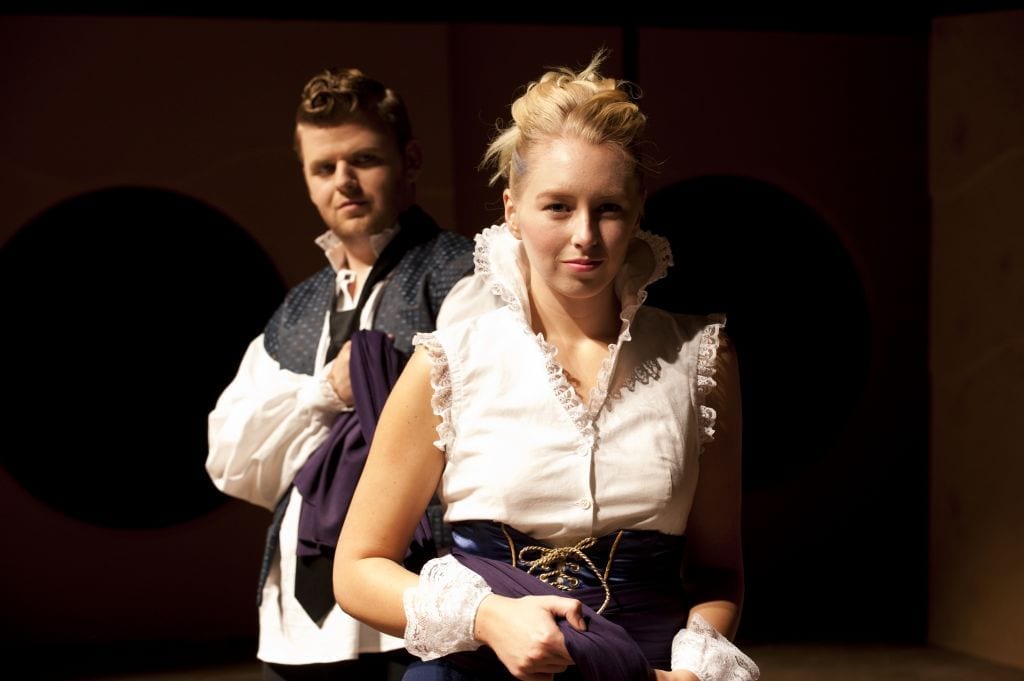SALT LAKE CITY — Who would have thought that a play about sexual scandal, incest, and murder could be so boring?
The University of Utah Department of Theatre’s latest production, ‘Tis Pity She’s a Whore, is the story of Giovanni and Annabella, a brother and sister who break the ultimate taboo and become sexually involved with each other. Written by John Ford some time in the early 1600’s, the play is a revenge tragedy that is surprisingly sympathetic in its treatment of the offending siblings, even when showing the drastic consequences of their actions.

Show closes November 18, 2012.
Sarah Shippobotham directs this production with pleasing creativity and a knack for introducing avant garde touches into the play. Most memorable is Shippobotham’s choice to have two scenes—one in each half of the play—between Giovanni and Annabella in which their interactions are physically mediated by a large piece of dark red cloth. The cloth at various times serves to distance the two siblings from each other, tie them closer, and cover their bodies. The cloth added wonderful stage business for the actors to do and helped emphasize the characters’ emotions and conflicts. Shippobotham was also skillful in scenes that required characters to change their mind and act in a way that they didn’t intend when the scene started. The confrontation scene between Soranzo (Logan Tarantino) and Annabella (Clara Osbeck) would have seemed nonsensical and sloppy in the hands of a less skilled director. Shippobotham, however, helped Tarantino develop an emotional and intellectual arc in the scene that made the character’s later actions make sense.
But the pacing of ‘Tis Pity She’s a Whore is incredibly slow for the first 90 minutes of the play (which runs just under 3 hours), and for that time there is very little tension in plot. On the other hand, the pacing problems may not be Shippobotham’s fault. There are large stretches of the script during which not much happens. I feel that Shippobotham produced great moments from time to time, but that she struggled to make the more mundane sections of the script very interesting. The result is an evening of theatre that for long periods of time is mundane and uniteresting.

Justin Tsatsa as Giovanni and Clara Osbeck as Annabella. Photo by Spencer Sandstrom.
I don’t envy Justin Tsatsa or Clara Osbeck in their roles as the scandalous brother and sister. These parts require the actors to balance the familiarity of siblings with the sexual interest of lovers. I don’t know if Tsatsa and Osbeck succeeded. But I am not sure that I would know what success in these roles would look like. Their angst when their characters were separated, though, was human and brought a touch of realism to a play that seems so removed from the existence of modern life. Among the supporting cast my two favorite performances came from Laura Rozema as Poggia and Christian Seiter as Vasquez. Rozema was vulnerable and tender when she expressed her unrequited love for her master, Bergetto (Mark Macey), in a way reminiscent of Eponine from Les Misérables. I was sad to see Rozema’s character drop out of the story, but thankfully Seiter’s character received more stage time to compensate. Seiter created a portrayal of Vasquez that was quite fascinating. Vasquez’s loyalty to his master was so boundless that he was able to engage in horrific atrocities to avenge Soranzo’s honor, and I found Seiter’s performance in this role fascinating.
I think the reason why these actors’ performances stand out in my mind is because most of the characters were flat. Ford either wasn’t capable of or interested in creating multidimensional characters. Even by Renaissance standards there is very little subtext in the script and many of the characters perform actions merely because that is what people of their social standing do or because it would advance the plot. Also, many of the characters’ actions don’t make a lot of sense. I didn’t understand, for example, why the friar (Paul Chaus) seemed slightly annoyed (instead of horrified and repulsed) when one of his parishioners confessed incest to him and why the friar later helped these unrepentant sinners communicate with each other. I also didn’t understand the choice to introduce cartoonish moments into the action, such as in Bergetto’s death or in Donada’s (Cathy Ostler Bearden) reactions when Poggia reads Berghetto’s letter.
Although I have said many negative things about this production, I want to emphasize that it is not without value. Listening to Ford’s words—written within the two decades after the end of Shakespeare‘s career—reminded me of how much literary diversity there was on the English Renaissance stage. It’s easy to fall into the trap of watching a lot of Shakespeare plays and believing that one understands the dramatic tastes of the English people 400 years ago. But London was (and still is) a bustling entertainment city with something to cater to every conceivable taste. Shakespeare’s plays were merely one option in this buffet of entertainment, and to equate classic English theatre with Shakespeare is simplistic. ‘Tis Pity She’s a Whore was another option that must have been chosen by some theatre goers in the 17th century, and it is best that modern theatre buffs understand the place of other playwrights in the historical time frame.
On the other hand, ‘Tis Pity She’s a Whore also reminded me of how brilliant Shakespeare was. Almost everything that Ford does in this play Shakespeare did earlier and better. Bergetto, for example, was a foolish dandy—a character type that Shakespeare more brilliantly worked into the beloved Benvolio. Giovanni’s soliloquies aren’t as psychologically deep or emotionally involving as Macbeth‘s or Hamlet‘s. And Ford’s poetic couplets are forgotten about as fast as the actors utter them, unlike the many quotable couplets that spring from so many of the Bard’s works.
What about the incest? It’s an integral part of the story, and it’s handled well by Shippobotham and her talented cast. Some people may be scandalized by the play’s content, and this production is definitely not appropriate for children or teenagers. But in the context of the plays of the era, it’s not terribly shocking. The plays of the previous generation contained cannibalism (Titus Andronicus), mutilation (King Lear), selling one’s soul to the devil (Dr. Faustus), and witchcraft (Macbeth), all of which were about as scandalous to audiences of the time as incest. I feel that Ford was merely trying to keep up with the taste for bizarre, shocking human behavior that his audiences demanded.
Finally, I wish to compliment the designers for this production. The costumes (designed by Kate Miller) were the perfect balance of 16th century clothing and 21st century fashion, which perfectly meshed with Shippobotham’s vision. I loved how doublets and corsets were paired with modern shoes and pants while never seeming odd. Also, Jesse Portillo‘s lighting design added texture to the mostly cream colored set. Portillo also helped establish mood and setting in ways that enhanced the story. His and Miller’s combined efforts made ‘Tis Pity She’s a Whore a wonderful play to look at, even when it wasn’t a wonderful play to watch.





